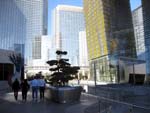
|

|
|
Home Site Search Contact Us Subscribe
|
|
An Open Letter to Susan Szenasy re: Frank Gehry By Fred A. Bernstein May 17, 2010 Susan,
I love and admire you.
But I think you are wrong about Frank Gehry.
I wasn’t at the event in Chicago. I read the account in Blair Kamin’s Chicago Tribune column.
According to Kamin, Gehry said the issue of green building is “finally a political one.” Gehry is absolutely right about that. And I don’t think the architect, as you put it, “summarily dismissed the movement that’s working to make the built environment more responsive to our deteriorated natural environment.” He merely dismissed the idea that LEED can solve the vast environmental problems we now face.
I publish some 50 articles a year, most of them on architecture. My work requires me to view hundreds of projects, and to read about thousands more. So I feel qualified to say that, far too often, LEED gives eco-cred to buildings that, in many cases, shouldn’t have been built. (Some call the process greenwashing.)
One example is CityCenter, the Las Vegas complex that contains more than 5,000 hotel rooms, plus casinos and shopping malls and restaurants and nightclubs – altogether, 18 million air-conditioned square feet smack in the middle of the Mojave Desert.
I can’t imagine a greater environmental disaster than this complex (which, in addition to requiring vast resources to build and operate, is designed to draw travelers from around the world). And yet it was awarded LEED Gold status.
Is CityCenter a net gain to the environment? No, it represents a huge net loss to the environment. And yet LEED gave it the cover of sustainability.
Without that cover, many more questions would have been raised about the decision to build CityCenter; perhaps it wouldn’t have been built at all. Gehry is right – the question is political. If there were robust public debate, Americans might decide that projects like CityCenter pose environmental costs that far outweigh their benefits. Zoning regulations, taxes, and other tools of government could then be used to stop such projects. LEED, by contrast, cannot stop wasteful projects from being built, nor does it attempt to.
As you know, LEED awards points for specific green features, without considering whether the project makes sense as a whole. That is true of nearly every checklist system, like the one in California that allowed a 10,000-square-foot house to receive a “green” designation.
Gehry’s other comments were innocuous. He said, “A lot of LEED is given for bogus stuff.” Everyone who has analyzed the point system, well-intentioned as it is, agrees with him.
And he said that the cost of making a building green may not “pay back in your lifetime.” That is certainly true, and it isn’t necessarily an argument against making buildings as sustainable as they can be. It was simply an elaboration of his central point: deciding what gets built is a political question. Since developers, with rare exceptions, won’t expend large sums of money for green features that won’t pay for themselves in three to five years, government has to step in, offering developers tax credits and other inducements to “go green.” Only the public can make that happen, by making its views known to politicians.
Using LEED as a measure of “sustainability” has allowed society to avoid tough questions – tough political questions – about what it should and shouldn’t build.
Best,
Fred Bernstein
Fred Bernstein has written about design for more than 15 years. He contributes to the New York Times, Metropolis, Architect, Architectural Record, and other publications.
Also by Bernstein:
In "Building Art: The Life and Work of Frank Gehry," Paul Goldberger's account of the architect's rise is also a tale of things not going Gehry's way.
Since 1931, the Empire State Building has been New York City's GPS, but with spate of supertalls obscuring the building, it could become hard to tell Manhattan from Kowloon or Pudong or Shinjuku or Canary Wharf.
Preservation Alert: P.S. 199, by Edward Durell Stone (1963) The public school on Manhattan's Upper West Side could be facing demolition if developer takes up New York City's offer to sell the site.
Mies built the Farnsworth in spitting distance of the mighty Fox River, and the house is paying price for his hubris.An Open Letter to Susan Szenasy re: Frank Gehry
Second Look: Pavilion and Colonnade Apartments by Mies van der Rohe, 1960 Newark, NJ: Current news about "starchitects" designing high-rise housing in New York is at an all-time high, but Mies did it across the Hudson River 46 years ago.
Second Look: Tracey Towers by Paul Rudolph, 1972 How did Rudolph, restless and challenging architectural mind, end up doing subsidized housing in the Bronx?
Op-Ed: The 2012 New York Olympics is lost. Long live the 2014 New York World's Fair.
Queens, NY: Its power undiminished after 40 years, a 20th century cathedral to science is about to be rediscovered as a luminous addition debuts this week.
Beauty in Garbage: Naka Incineration Plant by Yoshio Taniguchi Hiroshima: An incineration plant is devised as real-time science museum and tourist destination (complete with waterfront park).
Second Look: George Washington Bridge Bus Station / Pier Luigi Nervi, 1963 One of Nervi's few completed projects outside Italy is superb example of the poetry he wrought from ferro-concrete.
|
(click on pictures to enlarge)  Fred Bernstein CityCenter, Las Vegas |
© 2010 ArchNewsNow.com